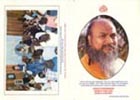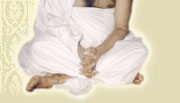PROGRAMS HOME PAGE | PREVIOUS PAGE



Mass feeding at the Bangalore ashram.

Bhajans (spiritual song) at the Jhansi birthday function.

Homa (offerings through sacred fire) at the Bangalore ashram.

Shivabalayogi at a Bangalore function.


MAHASHIVARATRI, Adivarapupeta, March 20, 2012

Certain dates are occasions for Shivabalayogi’s ashrams and devotees to organize special functions. They include Mahashivaratri, Swamiji’s birthday, the anniversary of his twelve-year tapas, and the date of his mahasamadhi. Devotees often distributed printed invitations to invite the general public, and Shri Swamiji particularly appreciated if his devotees organized mass feedings, serving a full meal without charge to all who attended.
Shivabalayogi himself had a travel routine in which he attended as many functions as he could. For Mahashivaratri, the “Great Night of Shiva,” he would travel to Adivarapupeta. He would celebrate his birthday and tapas anniversaries in Bangalore at the J. P. Nagar ashram, then shift to the old Bannerghatta Road ashram to observe the anniversary of his mother's mahasamadhi.
Mahashivaratri
The “Great Night of Shiva” falls on the moonless night of February or March. It celebrates the occasion when the gods and demons churned the cosmic ocean to extract the divine nectar, separating out the poison. It was Shiva, the Destroyer of illusion, who volunteered to drink the poison, giving him a blue throat and one of the many names by which he is known (Nilakantha — Blue Throat). Mahashivaratri is the major annual celebration for devotees of Shiva, God in the form of a Yogi, and Shiva is Shivabalayogi's Divine Guru.
After completing his twelve-year tapas, Shivabalayogi left his native village to begin three decades of almost constant traveling around India, then Sri Lanka, England and the United States. He promised devotees in the Adivarapupeta area that he would return annually each Mahashivaratri.
Mahashivaratri remains the major annual function at the Adivarapupeta ashram. Scores and hundreds of devotees from around India and the world attend the all-night bhajans, ending only at sunrise. That day there is a homa (yagna, offerings to the gods through a sacred fire), mass feeding for thousands, and the annual devotees’ meeting conducted by the International Trust. For several days before and after, there are celebrations for a ceremonial wedding of Shiva and Parvati, and devotees themselves organize rituals (puja) in which they bathe and worship the Shivalinga and statue of Parvati Devi that Shivabalayogi consecrated in the temple, and Shivabalayogi himself at the Samadhi.
Birthday & Tapas Anniversary
Shivabalayogi's birthday is January 24th, and it was on August 7th that he began and completed twelve years of tapas, meditation in samadhi. Both these dates are major celebrations at the main ashram in the J. P. Nagar area of south Bangalore.
The Bangalore functions begin with bhajans throughout the night before, then homa and a mass feeding on the day itself. In the temple are the statues of Ganesha, Subramanyan, Nandi, Brahma, Sarasawti, Vishnu, Lakshmi, Shiva, and Parvati that Shivabalayogi consecrated in 1987. During the functions, they and the Samadhi receive special, ritual bathing and worship, often with 108 large pitchers of water (abhishekam).
Shri Swamiji's birthday is also the occasion for one of the largest annual mass feeding given in honor of Shivabalayogi. It is organized not by an ashram, but by the devotees in Jhansi in north India. As at Shri Swamiji's ashrams, the Jhansi devotees also organize bhajans and a homa.
Parvatamma’s Mahasamadhi
Shivabalayogi designated August 15th as the date to honor the mahasamadhi of his beloved mother, Parvatamma Allaka. His mother's Samadhi-tomb is at the original Bangalore ashram on Bannerghatta Road. This function is another occasion for bhajans, bhava samadhi, a homa, and a mass feeding.
Mahasamadhi
Since Shivabalayogi dropped his own physical body on March 28, 1994, his devotees also commemorate that day. It is a special occasion to remember how Shivabalayogi gave of himself in service, and a day to remember and experience his continued presence in the world.
![]()
All these special occasions are observed among Shivabalayogi ashrams and devotees throughout India and the world.
These annual celebrations have been occasions for printed invitations for devotees and the general public to attend and share in the divine blessings. There is a long history of such invitations, and their artwork and expressions of devotion make them of particular interest. They are a way in which devotees communicate with each other.
There are many examples of these invitations at the Invitations gallery page.


